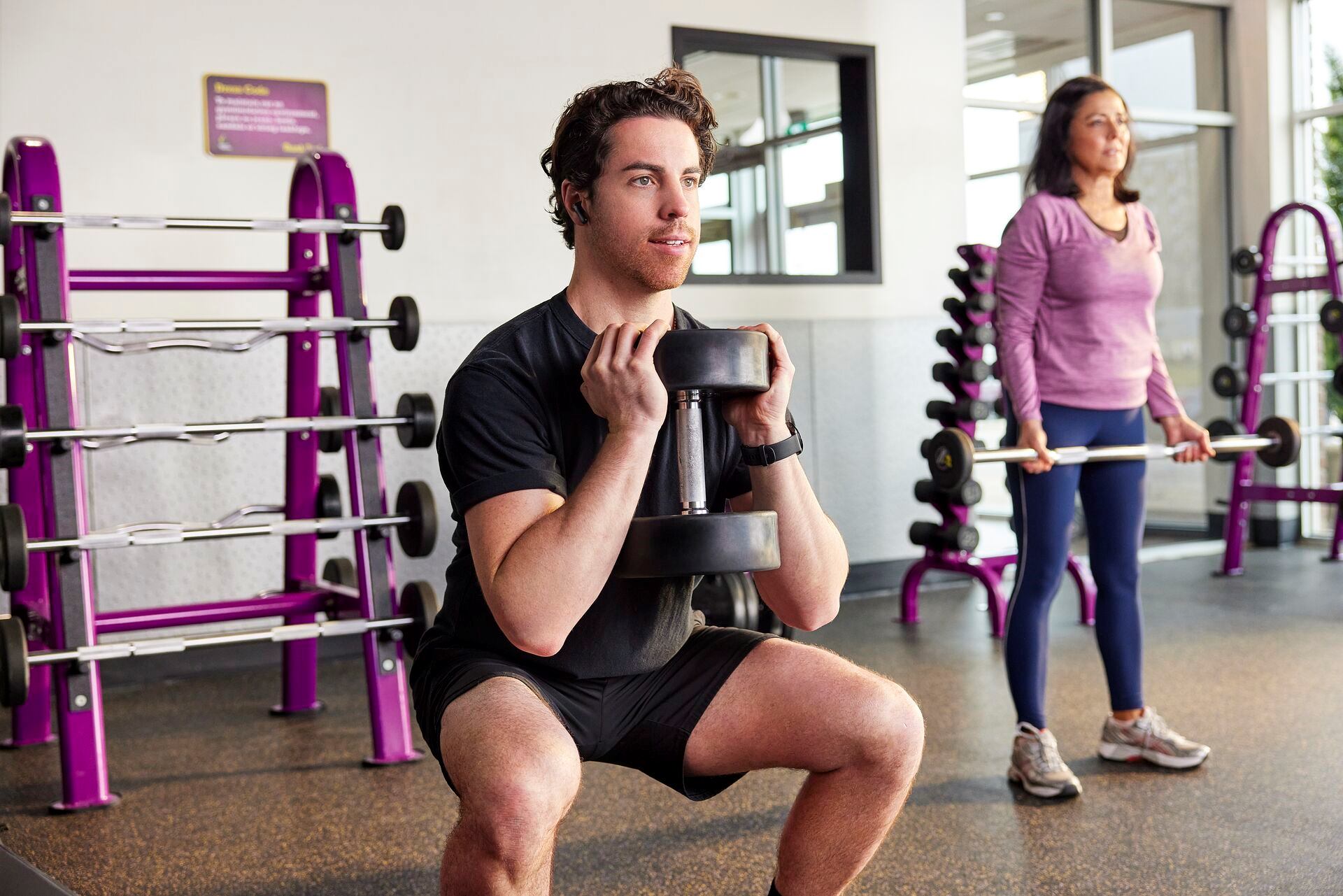Home>Misc>Featured>How Does Participating In Anaerobic Activities Improve Cardiovascular Fitness


Featured
How Does Participating In Anaerobic Activities Improve Cardiovascular Fitness
Modified: January 22, 2024
Discover how participating in featured anaerobic activities can significantly improve your cardiovascular fitness, enhancing overall health and wellness.
Introduction
Physical fitness plays a crucial role in maintaining overall health and well-being. When it comes to cardiovascular fitness, many individuals focus solely on aerobic activities, such as running, swimming, or cycling. While these activities are undoubtedly beneficial, there’s another type of exercise that shouldn’t be overlooked: anaerobic activities.
Anaerobic activities refer to high-intensity exercises that are performed in short bursts, typically lasting for a few seconds to a few minutes. Unlike aerobic exercises, which primarily rely on oxygen to fuel the muscles, anaerobic activities rely on stored energy sources within the muscles, such as ATP (adenosine triphosphate) and glycogen.
Cardiovascular fitness, also known as aerobic fitness, refers to the ability of the heart, lungs, and blood vessels to efficiently deliver oxygen and nutrients to the muscles during sustained physical activity. It is a crucial component of overall fitness and has numerous health benefits, including a reduced risk of heart disease, improved stamina, and enhanced mental well-being.
While aerobic exercises are excellent for improving cardiovascular fitness, incorporating anaerobic activities into your fitness routine can further enhance your cardiovascular health. In this article, we will explore how participating in anaerobic activities can improve your cardiovascular fitness and contribute to your overall well-being.
Definition of Anaerobic Activities
Anaerobic activities are high-intensity exercises that push your body to work at its maximum capacity for a short period of time. These activities rely on the body’s stored energy sources rather than oxygen to fuel the muscles. They typically involve rapid, explosive movements that engage large muscle groups.
Unlike aerobic activities that are characterized by longer durations and steady-state movements, anaerobic activities require maximum effort and often involve intervals of rest between sets or exercises. They aim to improve power, speed, and strength.
Examples of anaerobic activities include weightlifting, sprinting, high-intensity interval training (HIIT), circuit training, and plyometric exercises. These exercises typically last from a few seconds to a few minutes, challenging your body’s energy systems and pushing your limits.
During anaerobic activities, your body taps into its reserves of ATP and glycogen to provide the necessary fuel for muscular contractions. As these energy sources are used up quickly, the body cannot sustain the same level of intensity for a prolonged period.
Engaging in anaerobic activities can lead to various physiological changes in your body, including increased muscle strength, power, and endurance. These exercises also have a profound impact on cardiovascular fitness, which we will explore further in the following sections.
Definition of Cardiovascular Fitness
Cardiovascular fitness, also known as aerobic fitness, refers to the ability of the cardiovascular system to efficiently transport oxygen and nutrients to the body’s muscles during sustained physical activity. It is a measure of how well the heart, lungs, and blood vessels work together to deliver oxygen-rich blood to the working muscles.
When you engage in aerobic activities, such as jogging, swimming, or cycling, your heart rate increases, and your breathing becomes deeper and more rapid. This elevated heart rate and increased oxygen consumption stimulate the cardiovascular system to adapt and become more efficient.
Regular aerobic exercise improves the functioning of the heart and lungs, increases the size and efficiency of the heart muscle, and enhances the oxygen-carrying capacity of the blood. It strengthens the cardiovascular system, improving overall endurance, reducing the risk of heart disease, and improving overall health and well-being.
Cardiovascular fitness is often assessed by measuring the maximum amount of oxygen that an individual can consume during intense exercise, known as VO2 max. The higher the VO2 max, the greater the cardiovascular fitness, indicating a better ability to transfer oxygen to the working muscles.
Improved cardiovascular fitness not only benefits physical health but also has positive effects on mental well-being. Regular aerobic exercise has been shown to reduce stress and anxiety, improve mood, boost cognitive function, and enhance overall quality of life.
Benefits of Participating in Anaerobic Activities for Cardiovascular Fitness
While aerobic exercises are commonly associated with cardiovascular fitness, incorporating anaerobic activities into your fitness routine can provide additional benefits and further enhance your cardiovascular health. Here are some key advantages of participating in anaerobic activities:
1. Increased heart strength and efficiency: Anaerobic activities, such as high-intensity weightlifting and sprinting, require a significant amount of force from your muscles. This increased demand places stress on your cardiovascular system, resulting in the adaptation of your heart to pump more effectively. Over time, this leads to improved heart strength and efficiency, enhancing cardiovascular fitness.
2. Improved oxygen delivery to muscles: Anaerobic activities improve the efficiency of oxygen delivery to the muscles by increasing the number of capillaries and blood vessels. This greater network of vessels allows for faster and more efficient oxygen transport, promoting better performance during both anaerobic and aerobic exercises.
3. Enhanced endurance and stamina: Participating in anaerobic activities challenges your body to work at higher intensities for shorter durations. This type of training helps improve your anaerobic threshold, allowing you to perform at higher intensities for longer periods. As a result, your overall endurance and stamina are greatly enhanced, benefiting your cardiovascular fitness.
4. Increased metabolic efficiency: Anaerobic activities promote the development of lean muscle mass. As muscle tissue is more metabolically active than fat, having more muscle mass increases your basal metabolic rate (BMR). This means that even at rest, your body will burn more calories and efficiently utilize energy, aiding in weight management and improving cardiovascular health.
5. Reduction in resting heart rate: Engaging in anaerobic activities on a regular basis can lead to a decrease in resting heart rate. This is because a stronger and more efficient heart does not need to work as hard to pump blood, resulting in a lower resting heart rate. A lower resting heart rate is a marker of good cardiovascular health and is associated with a reduced risk of heart disease.
6. Prevention of cardiovascular diseases: Regular anaerobic training has been shown to improve lipid profiles by increasing high-density lipoprotein (HDL) and decreasing triglyceride levels. It can also help regulate blood pressure and reduce inflammation, all of which contribute to a lower risk of developing cardiovascular diseases.
Incorporating anaerobic activities into your fitness routine not only promotes muscle strength and power but also yields significant cardiovascular benefits. By challenging your body with high-intensity exercises, you can improve heart health, increase oxygen delivery to muscles, enhance endurance, and reduce the risk of cardiovascular diseases. Aim for a well-rounded fitness routine that includes both aerobic and anaerobic activities to optimize your cardiovascular fitness and overall well-being.
Increased Heart Strength and Efficiency
One of the key benefits of participating in anaerobic activities for cardiovascular fitness is the increased strength and efficiency of the heart. Anaerobic exercises, such as high-intensity weightlifting and sprinting, place a significant demand on your muscles, which in turn places stress on your cardiovascular system.
During anaerobic activities, your heart needs to work harder to deliver oxygen-rich blood to the muscles and remove waste products like lactic acid. This increased demand on the heart causes it to adapt and become stronger over time. The heart muscle becomes more efficient at pumping blood, resulting in a greater stroke volume (the amount of blood pumped with each heartbeat).
As the heart becomes stronger, it can pump out more blood with each contraction, which means more oxygen and nutrients are delivered to the working muscles. This improved oxygen delivery enhances muscular performance, allowing you to perform at higher intensities and for longer durations.
In addition to increased strength, the heart also becomes more efficient at its job. It becomes better at filling up with blood during the relaxation phase (diastole), which leads to a greater volume of blood being pumped out during the contraction phase (systole). This efficiency translates to a lower resting heart rate as the heart does not need to work as hard to supply the body with the necessary oxygen and nutrients.
By engaging in regular anaerobic activities, you can strengthen your heart muscle and improve its overall efficiency. This has numerous benefits, including better cardiovascular fitness, improved exercise performance, and reduced risk of cardiovascular diseases.
It’s important to note that the increased heart strength and efficiency derived from anaerobic activities complement the benefits of aerobic exercises. By incorporating both types of exercise into your fitness routine, you can maximize your cardiovascular health and improve your overall fitness.
Improved Oxygen Delivery to Muscles
Participating in anaerobic activities is not only beneficial for building strength and power but also for improving the delivery of oxygen to your muscles. When you engage in high-intensity anaerobic exercises, your body adapts to meet the increased demand for oxygen by improving its oxygen delivery mechanisms.
One way anaerobic activities enhance oxygen delivery is by increasing the number of capillaries and blood vessels in your muscles. Capillaries are microscopic blood vessels that exchange oxygen and nutrients with the surrounding tissues. By regularly engaging in anaerobic exercises, you stimulate the growth of new capillaries, creating a denser network within your muscles. This increased network allows for more efficient oxygen delivery, ensuring that your muscles receive the necessary oxygen to perform at their best.
Additionally, anaerobic activities also improve the efficiency of the existing blood vessels. The walls of blood vessels become more elastic, allowing for better dilation and increased blood flow. This improved vasodilation ensures that oxygenated blood is delivered to the muscles more effectively, enhancing their performance during exercise.
Another way anaerobic activities improve oxygen delivery is by increasing the oxygen-carrying capacity of your blood. High-intensity exercises stimulate the production of red blood cells, which carry oxygen from your lungs to your muscles. As you continue to engage in anaerobic exercises, your body responds by producing more red blood cells, effectively enhancing your blood’s ability to transport oxygen to the working muscles.
Improved oxygen delivery to your muscles during exercise has several benefits. It allows your muscles to perform at higher intensities for longer durations without fatigue. This increased endurance can improve your overall athletic performance and contribute to better cardiovascular fitness.
Moreover, the improved oxygen delivery from anaerobic activities can also enhance recovery after workouts. Oxygen is vital for repairing and restoring muscle tissues, and increased oxygen supply helps reduce muscle soreness and inflammation, allowing for faster recovery between workouts.
By participating in anaerobic activities, you can improve the delivery of oxygen to your muscles, thereby enhancing their performance and contributing to better cardiovascular fitness. The combination of increased capillaries, improved blood vessel efficiency, and enhanced oxygen-carrying capacity of the blood all work together to optimize oxygen delivery, ensuring your muscles receive the necessary fuel to perform at their best.
Enhanced Endurance and Stamina
Engaging in anaerobic activities can have a significant impact on your endurance and stamina levels. While these exercises are known for their power and strength-building benefits, they also play a crucial role in improving your cardiovascular fitness and increasing your overall endurance.
When you perform high-intensity anaerobic activities, such as sprinting or intense resistance training, your body is forced to operate at its maximum capacity for short durations. This type of training pushes your anaerobic threshold, which is the point at which your body transitions from relying primarily on aerobic energy production to anaerobic energy production.
By consistently challenging your anaerobic threshold through anaerobic activities, you train your body to tolerate and maintain high levels of exertion. Over time, this leads to an increase in your overall endurance and stamina levels.
Improved endurance and stamina have several benefits for cardiovascular fitness. Firstly, they allow you to sustain physical activity for longer periods without experiencing fatigue. This means you can engage in aerobic exercises, such as running or cycling, at higher intensities for extended durations, thereby further enhancing your cardiovascular fitness.
Enhanced endurance and stamina also translate to improved performance in everyday activities. Whether it’s climbing stairs, carrying groceries, or participating in sports, having greater endurance and stamina enables you to perform these activities with ease and without feeling excessively tired.
Furthermore, improved endurance can directly impact your cardiovascular health. As you engage in anaerobic activities that push your heart rate and challenge your cardiovascular system, your heart adapts by becoming stronger and more efficient. This not only improves its ability to pump oxygen-rich blood to the muscles but also reduces the stress on the heart during daily activities.
Regular participation in anaerobic activities not only improves your overall strength and power but also enhances your endurance and stamina. This increased capacity to tolerate and sustain high-intensity efforts benefits both your cardiovascular fitness and your ability to engage in various physical activities. By pushing your limits and expanding your endurance through anaerobic training, you can reach new levels of fitness and achieve optimal cardiovascular health.
Increased Metabolic Efficiency
An often overlooked benefit of participating in anaerobic activities for cardiovascular fitness is the increase in metabolic efficiency. Anaerobic exercises not only promote muscle strength and power but also have a positive impact on your body’s metabolic processes, leading to improved overall efficiency.
During anaerobic activities, your body taps into its stored energy sources, such as ATP and glycogen, to fuel the intense bursts of exercise. This process requires a significant amount of energy and triggers adaptations within your body’s metabolism.
One of the key effects of anaerobic exercise on metabolism is the increase in basal metabolic rate (BMR). BMR refers to the number of calories your body burns at rest to maintain basic bodily functions, such as breathing, circulating blood, and maintaining body temperature. By engaging in anaerobic activities, you stimulate muscle growth and development, as well as improve the metabolic demand on the body. As a result, your BMR increases, leading to a higher rate of calorie burn even when you are not exercising.
Additionally, anaerobic activities also contribute to improved metabolic efficiency during exercise. These exercises require a swift and coordinated effort from different muscle groups, which leads to the recruitment of a larger number of muscle fibers. This increased recruitment of muscle fibers during anaerobic activities requires more energy, leading to higher calorie expenditure during the workout.
Moreover, the intensity of anaerobic activities triggers a physiological response known as Excess Post-Exercise Oxygen Consumption (EPOC). After intense exercise, your body continues to consume additional oxygen to replenish energy stores, remove metabolic by-products, and restore body temperature. This post-exercise oxygen consumption leads to an increased calorie burn for hours after your anaerobic workout, further contributing to metabolic efficiency.
By engaging in regular anaerobic activities, your body becomes more metabolically efficient in utilizing energy. This increased metabolic efficiency can have a positive impact on weight management, as it allows for better utilization of calories and increased fat burning potential. Additionally, higher metabolic efficiency can lead to improved overall energy levels and promote better overall health.
It’s important to note that while anaerobic activities do provide metabolic benefits, a well-rounded fitness routine that incorporates both aerobic and anaerobic exercises is ideal for optimizing metabolic efficiency and achieving overall cardiovascular fitness and health.
Reduction in Resting Heart Rate
Participating in anaerobic activities can lead to a reduction in resting heart rate, which is a key indicator of good cardiovascular health. Resting heart rate refers to the number of times your heart beats per minute while at rest and is influenced by factors such as age, fitness level, and overall cardiovascular fitness.
Engaging in regular anaerobic activities improves cardiovascular fitness and strengthens the heart muscle. As your heart becomes stronger and more efficient, it can pump a larger volume of blood with each heartbeat. This increased efficiency allows the heart to meet the body’s demands with fewer beats per minute, leading to a lower resting heart rate over time.
By regularly challenging your cardiovascular system through high-intensity anaerobic exercises, you stimulate the heart to work more efficiently. The heart adapts to the increased demands placed on it during these exercises by becoming stronger and more capable of delivering oxygen-rich blood to the muscles. As a result, it does not need to work as hard during rest periods, resulting in a decreased resting heart rate.
Having a lower resting heart rate is associated with several benefits. Firstly, it is an indication of improved overall cardiovascular fitness. A lower resting heart rate suggests that your heart is strong and able to efficiently distribute blood throughout your body. It also indicates that your heart is not under excessive stress and is better able to handle daily activities.
A lower resting heart rate is also linked to a reduced risk of cardiovascular diseases. Research has shown that individuals with lower resting heart rates have a lower risk of developing conditions such as hypertension, heart disease, and stroke. This is because a lower resting heart rate indicates a healthier heart and better overall cardiovascular function.
Furthermore, a lower resting heart rate can improve athletic performance. It allows the body to sustain higher levels of physical activity for longer durations without experiencing fatigue. This enhanced endurance capacity can enable athletes to perform better in their chosen sports or activities.
It’s important to note that while engaging in anaerobic activities can contribute to a reduction in resting heart rate, it is vital to maintain a balanced approach to exercise. Combining anaerobic exercises with aerobic activities, such as jogging or cycling, will provide a comprehensive cardiovascular workout and further optimize your resting heart rate and overall cardiovascular fitness.
Prevention of Cardiovascular Diseases
Participating in anaerobic activities plays a crucial role in the prevention of cardiovascular diseases. Cardiovascular diseases, such as heart disease, stroke, and hypertension, are leading causes of morbidity and mortality worldwide. Incorporating regular anaerobic exercises into your fitness routine can significantly reduce the risk of developing these conditions.
Engaging in high-intensity anaerobic activities helps improve various risk factors associated with cardiovascular diseases. Here’s how anaerobic exercises contribute to the prevention of these conditions:
1. Improved lipid profiles: Anaerobic activities have been shown to lower levels of LDL (bad) cholesterol and increase levels of HDL (good) cholesterol in the blood. This improvement in lipid profiles helps reduce the build-up of plaque in the arteries, reducing the risk of atherosclerosis and heart disease.
2. Regulation of blood pressure: Regular participation in anaerobic activities has been found to help regulate blood pressure levels. High-intensity exercises improve the elasticity of blood vessels, leading to better blood flow and a reduction in hypertension. This helps to lower the risk of cardiovascular diseases like stroke and heart failure.
3. Reduction in inflammation: Anaerobic exercises have anti-inflammatory effects on the body. They can help reduce chronic low-grade inflammation, which is associated with the development of various cardiovascular diseases. By reducing inflammation, anaerobic exercises contribute to a healthier cardiovascular system.
4. Enhanced insulin sensitivity: Anaerobic activities improve insulin sensitivity in the body. This means that the body becomes more efficient at using glucose for energy and regulating blood sugar levels. Improved insulin sensitivity reduces the risk of developing diabetes, a condition that significantly increases the risk of heart disease.
5. Maintenance of a healthy body weight: Anaerobic exercises promote the development of lean muscle mass, which helps increase the body’s metabolic rate. This increase in metabolism leads to a greater calorie burn, aiding in weight management and reducing the risk of obesity. Maintaining a healthy body weight is crucial in preventing cardiovascular diseases.
6. Reduction in stress and anxiety: Engaging in anaerobic activities can help reduce stress and anxiety levels. Chronic stress is associated with an increased risk of cardiovascular diseases. By managing stress levels through regular exercise, including anaerobic activities, you can promote a healthier cardiovascular system.
By participating in anaerobic activities, you can significantly reduce the risk of developing cardiovascular diseases. These exercises improve lipid profiles, regulate blood pressure, reduce inflammation, enhance insulin sensitivity, aid in weight management, and reduce stress levels. Incorporating anaerobic exercises into your fitness routine can help you maintain a healthy cardiovascular system and promote overall heart health.
Examples of Anaerobic Activities
There are various types of anaerobic activities that you can incorporate into your fitness routine to improve your cardiovascular fitness. These exercises are characterized by high-intensity, explosive movements that engage large muscle groups. Here are some examples of anaerobic activities:
1. Weightlifting: Weightlifting is a popular anaerobic activity that involves using resistance, such as dumbbells, barbells, or weight machines, to build strength and power. Exercises like squats, deadlifts, and bench presses are examples of weightlifting movements that engage multiple muscle groups and challenge your cardiovascular system.
2. Sprinting: Sprinting is a fantastic way to engage in anaerobic exercise. Whether you’re running sprints on a track or performing intervals on a stationary bike, sprinting pushes your body to its maximum capacity for a short period. This high-intensity exercise challenges your cardiovascular fitness, improves muscle power, and enhances overall stamina.
3. High-Intensity Interval Training (HIIT): HIIT involves alternating between short bursts of intense exercise and brief rest periods. This type of training stimulates both the aerobic and anaerobic energy systems, making it an effective way to improve cardiovascular fitness. HIIT workouts can include exercises like burpees, jumping jacks, and kettlebell swings, performed at a high intensity for a specific duration.
4. Circuit Training: Circuit training involves performing a series of exercises, typically targeting different muscle groups, with minimal rest in between. This form of training keeps your heart rate elevated throughout the workout, providing both aerobic and anaerobic benefits. Circuit training can include exercises like push-ups, squats, lunges, and plyometric movements.
5. Plyometric Exercises: Plyometric exercises, also known as jump training, are explosive movements that involve rapid muscle contractions. These exercises, such as box jumps, jump squats, and burpees, help improve power, speed, and muscular strength. They also challenge your cardiovascular system, as they require quick bursts of energy.
6. Sport-Specific Drills: Engaging in sport-specific drills can also provide anaerobic benefits. Exercises like agility ladder drills, shuttle runs, and sports-specific movements help improve speed, quickness, and overall anaerobic fitness. These drills mimic the demands of the sport and enhance cardiovascular endurance needed for high-intensity game situations.
Incorporating a variety of these anaerobic activities into your fitness routine allows you to target different muscle groups and energy systems, leading to overall cardiovascular improvement. Remember to start gradually and listen to your body, gradually increasing the intensity and duration of your workouts. It’s always a good idea to consult with a fitness professional to ensure you’re performing the exercises correctly and customizing your routine to your fitness level and goals.
Weightlifting
Weightlifting is a popular and effective anaerobic activity that involves lifting weights or using resistance to build strength, power, and muscle mass. It is a versatile form of exercise that targets different muscle groups and provides numerous benefits for cardiovascular fitness.
When you engage in weightlifting, you challenge your muscles to overcome resistance, whether it’s through free weights, weight machines, or bodyweight exercises. This resistance training stimulates the muscle fibers, leading to hypertrophy (muscle growth) and improved muscular strength.
Weightlifting workouts typically consist of sets and repetitions. A set refers to a specific number of repetitions of a particular exercise. By progressively increasing the weights and intensity over time, weightlifting workouts can become increasingly challenging, pushing your muscles and cardiovascular system to adapt and improve.
One of the primary benefits of weightlifting for cardiovascular fitness is its impact on heart health. The high-intensity nature of weightlifting increases demand on the cardiovascular system, leading to improved heart strength and efficiency. Studies have shown that regular weightlifting can lower resting heart rate, improve blood pressure, and enhance overall cardiovascular function.
Weightlifting also has positive effects on body composition. By increasing muscle mass, weightlifting boosts your basal metabolic rate (BMR), which means you burn more calories even at rest. This contributes to weight management and can help prevent obesity, a risk factor for cardiovascular diseases.
Weightlifting is not just for bulking up. It also plays a crucial role in injury prevention and rehabilitation. By strengthening muscles and improving joint stability, weightlifting helps protect the body from injuries and aids in the recovery process after an injury or surgery.
Incorporating weightlifting into your fitness routine can enhance your overall functional fitness as well. It improves not only muscular strength but also bone density, joint health, and overall physical performance. These improvements allow you to perform daily activities with greater ease and reduce the risk of age-related functional decline.
It’s important to note that proper form and technique are crucial when engaging in weightlifting. It is recommended to seek guidance from a qualified fitness professional or strength and conditioning coach to learn the proper techniques and ensure safety during workouts. Gradually progress in weights and intensity over time to allow for adaptation and minimize the risk of injury.
Weightlifting is a powerful anaerobic activity that offers a multitude of benefits for cardiovascular fitness and overall well-being. By incorporating weightlifting exercises into your workout routine, you can improve heart health, increase muscle strength, enhance body composition, and enhance your overall functional fitness.
Sprinting
Sprinting is a highly intense anaerobic activity that involves running or cycling at maximum speed. It is an explosive and powerful form of exercise that provides a range of benefits for cardiovascular fitness and overall athletic performance.
When you sprint, you engage your fast-twitch muscle fibers, which are responsible for generating quick bursts of power. This high-intensity exercise stimulates the cardiovascular system, pushing your heart and lungs to work harder to meet the oxygen demands of your working muscles.
Sprinting can be performed in various ways, including short-distance sprints, hill sprints, or sprint intervals. It requires maximal effort and typically lasts from a few seconds to a minute. This type of exercise challenges your body’s anaerobic energy systems, improving their efficiency while also providing cardiovascular benefits.
One of the primary advantages of sprinting is its ability to improve cardiovascular fitness and endurance. Regular sprint training increases your VO2 max, which refers to the maximum amount of oxygen your body can use during intense exercise. By repeatedly pushing your anaerobic threshold, sprinting prompts the body to adapt and become more efficient at utilizing oxygen, leading to improved cardiovascular fitness.
Sprinting also has a positive impact on body composition. Due to its high intensity, sprinting burns a significant amount of calories both during and after the workout. This calorie expenditure can help in weight management, fat loss, and the development of lean muscle mass. Sprinting can contribute to a decrease in body fat percentage and an improvement in overall body composition.
In addition to cardiovascular and body composition benefits, sprinting can also enhance your speed, power, and coordination. The explosive nature of sprinting engages and strengthens your leg muscles, including your quadriceps, hamstrings, glutes, and calves. Improved lower body strength translates to better performance in sports, activities requiring quick bursts of speed, and overall athletic ability.
Sprinting is a versatile exercise that can be performed both indoors and outdoors. Whether it’s on a track, a treadmill, or a stationary bike, sprinting allows for variations and adaptations to suit individual preferences and fitness levels.
It’s important to note that proper warm-up and progression are essential when incorporating sprinting into your fitness routine. Gradually increasing workout duration and intensity helps prevent injuries and allows for optimal adaptation. It can be beneficial to seek guidance from a fitness professional or coach, especially if you are new to sprinting or have any underlying health conditions.
Sprinting is an effective anaerobic activity that offers a range of benefits, including improved cardiovascular fitness, enhanced body composition, increased speed and power, and improved overall athletic performance. By incorporating sprinting into your fitness routine, you can challenge your cardiovascular system, boost your fitness level, and achieve your fitness goals.
High-Intensity Interval Training (HIIT)
High-Intensity Interval Training (HIIT) is a popular and time-efficient form of anaerobic exercise that involves alternating between short bursts of high-intensity exercise and brief periods of rest or lower-intensity activity. This form of training challenges both the aerobic and anaerobic energy systems, providing numerous benefits for cardiovascular fitness and overall health.
HIIT workouts are characterized by their intensity and variability. The intense intervals push you to your maximum effort, elevating your heart rate and challenging your cardiovascular system. The recovery periods allow for brief rest or active recovery, allowing your body to recover before the next intense interval.
The key advantage of HIIT is its effectiveness in improving cardiovascular fitness in a shorter amount of time compared to traditional aerobic exercises. The high-intensity intervals push your body to work at or near its maximum capacity, stimulating various physiological adaptations.
During the intense intervals, your heart rate increases significantly, enhancing the strength and efficiency of your heart. This leads to improved cardiovascular endurance and the ability to sustain high-intensity efforts for longer durations.
HIIT workouts also promote fat burning and improve body composition. The intense intervals create an “afterburn” effect called Excess Post-Exercise Oxygen Consumption (EPOC). This increases your metabolic rate, causing your body to burn calories even after the workout is complete. The combination of calorie burn during the exercise and the elevated post-workout burn leads to greater fat loss and improved overall body composition.
Another benefit of HIIT is its efficacy in reducing insulin resistance and improving insulin sensitivity. The intense exercise stimulates glucose uptake into the muscles, helping to regulate blood sugar levels and lower the risk of developing type 2 diabetes.
HIIT workouts are highly versatile and can be adapted to various fitness levels and preferences. They can be performed using various forms of exercise, such as running, cycling, bodyweight exercises, or even cardio machines like treadmills or ellipticals. The flexibility of HIIT allows for customization to suit individual goals and time constraints.
It’s important to note that HIIT workouts should be approached with caution, especially if you are new to exercise or have any underlying health conditions. Starting gradually, with shorter intervals and longer recovery periods, allows your body to adapt and minimize the risk of injury. It can also be beneficial to seek guidance from a fitness professional to ensure proper form and progression.
Whether you’re looking to improve cardiovascular fitness, burn calories, or enhance overall health, incorporating HIIT into your fitness routine can be highly beneficial. Its effectiveness, efficiency, and versatility make it a popular choice for individuals seeking a challenging anaerobic workout that yields excellent cardiovascular and metabolic benefits.
Circuit Training
Circuit training is a dynamic and time-efficient form of anaerobic exercise that involves performing a series of exercises in a specific order, with minimal rest in between. It is a versatile and challenging workout that targets multiple muscle groups while providing cardiovascular benefits.
A circuit typically consists of several different exercises that cover a range of muscle groups or movement patterns. These exercises can include bodyweight exercises, resistance exercises, or a combination of both. Participants move from one exercise to the next, working at a high intensity for a set amount of time or a specific number of repetitions.
The key advantage of circuit training is its ability to keep the heart rate elevated throughout the workout, providing both cardiovascular and strength-building benefits. The intense nature of circuit training challenges your cardiovascular fitness, promoting improvements in endurance and stamina.
Due to its fast-paced and intense nature, circuit training also has the potential to provide a significant calorie burn. Moving quickly from one exercise to the next and engaging different muscle groups increases energy expenditure, making it an effective option for weight management and fat loss.
Additionally, circuit training stimulates muscle growth and strength development. The combination of resistance exercises and minimal rest periods creates muscular fatigue, prompting the body to adapt and become stronger. This leads to increased muscle strength, power, and overall functional fitness.
Circuit training offers a range of benefits, such as improved cardiovascular fitness, increased muscle strength, enhanced muscular endurance, and efficient calorie burn. It also offers variety and flexibility, as circuits can be customized to suit individual preferences, fitness levels, and equipment availability.
Furthermore, circuit training can be adapted to target specific goals or address specific needs. It can focus on strength-building with heavier weights and fewer repetitions, or it can emphasize cardio and endurance with lighter weights and higher repetitions. This flexibility allows individuals to tailor their workouts for optimal results.
It’s essential to pay attention to proper form and technique during circuit training to minimize the risk of injury. Beginners may wish to start with a reduced number of exercises or longer rest periods to gradually build up their cardiovascular and muscular endurance.
Integrating circuit training into your fitness routine is an excellent way to improve cardiovascular fitness, enhance muscle strength and endurance, and burn calories efficiently. Whether you’re looking to challenge yourself, maximize time efficiency, or vary your workout routine, circuit training provides a versatile and effective anaerobic exercise option.
Plyometric Exercises
Plyometric exercises, also known as jump training or plyos, are high-intensity anaerobic exercises that involve rapid and explosive movements. These exercises focus on using your muscles’ elastic energy to generate maximum force in a short amount of time. Plyometric exercises develop power, speed, and overall athletic performance while providing cardiovascular benefits.
Examples of plyometric exercises include box jumps, jump squats, burpees, clap push-ups, and skipping. These exercises typically involve a quick stretch of the muscles followed by a forceful contraction, resulting in a powerful and explosive movement. Plyometric exercises engage both the muscles and the cardiovascular system, making them highly effective for improving cardiovascular fitness.
Plyometric exercises challenge your muscles to produce maximal force in a short time, leading to improved muscle power and strength. The rapid movements force your muscles to contract more forcefully than during traditional resistance exercises, stimulating muscle fibers to grow and adapt. This increased muscle power translates to improvements in athletic performance, including speed, agility, and vertical jump height.
In addition to building muscle power, plyometric exercises also have a significant impact on cardiovascular fitness. The explosive movements of plyos increase your heart rate and challenge your cardiovascular system. This high-intensity nature helps improve cardiovascular endurance and stamina over time.
Engaging in plyometric exercises can also promote optimal neuromuscular coordination. The quick and coordinated movements required in plyos improve communication between your muscles and nervous system, leading to better efficiency, precision, and overall performance in various physical activities.
Plyometric exercises can be modified and tailored to suit various fitness levels and goals. Beginners can start with low-impact variations, such as squat jumps or step-ups, and gradually progress to more advanced plyos as strength and coordination improve. It’s crucial to focus on proper technique and landing mechanics to minimize the risk of injury and maximize the benefits.
When incorporating plyometric exercises into your fitness routine, it’s essential to allow for adequate rest and recovery between sessions. Plyometric exercises place a high demand on your muscles and joints, so it’s vital to listen to your body and avoid overtraining to prevent injury and maintain optimal performance.
Whether you’re an athlete aiming to improve performance or simply looking to add variety and intensity to your workouts, plyometric exercises are an excellent choice. Their ability to develop explosive power, enhance cardiovascular fitness, and improve neuromuscular coordination make them a valuable addition to any fitness regimen.
Conclusion
Participating in anaerobic activities can have a profound impact on cardiovascular fitness and overall health. These high-intensity exercises, such as weightlifting, sprinting, HIIT, circuit training, and plyometric exercises, offer a range of benefits that complement traditional aerobic exercises.
Anaerobic activities improve cardiovascular fitness by increasing heart strength and efficiency, enhancing oxygen delivery to muscles, boosting endurance and stamina, improving metabolic efficiency, reducing resting heart rate, and preventing cardiovascular diseases.
Weightlifting challenges muscles and strengthens the heart, while sprinting improves cardiovascular endurance and increases speed and power. HIIT provides an efficient way to enhance cardiovascular fitness and burn calories, and circuit training keeps the heart rate elevated while working on muscular strength and endurance. Plyometric exercises develop explosive power, improve cardiovascular fitness, and enhance neuromuscular coordination.
When incorporating anaerobic activities into your fitness routine, it’s important to start gradually, focus on proper form and technique, and listen to your body to prevent injuries and optimize results. It’s also crucial to balance anaerobic activities with aerobic exercises to achieve overall cardiovascular fitness.
By embracing anaerobic activities, you can improve your cardiovascular health, increase muscle strength and power, enhance endurance and stamina, and enjoy the numerous physical and mental benefits that come with an active lifestyle. Whether your goal is to improve athletic performance, manage body weight, or prevent cardiovascular diseases, anaerobic activities provide a versatile and effective means of achieving your fitness aspirations.
So, don’t shy away from the intensity. Embrace the challenge, push your limits, and reap the rewards of participating in anaerobic activities for cardiovascular fitness and overall well-being.









